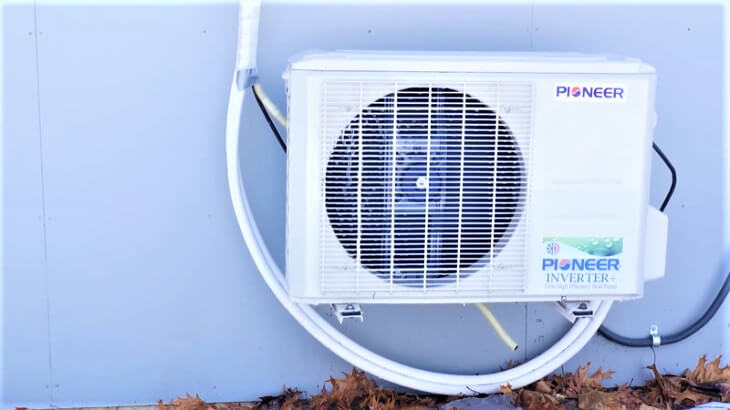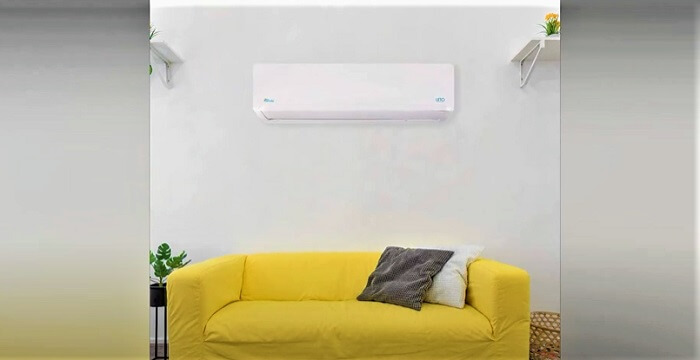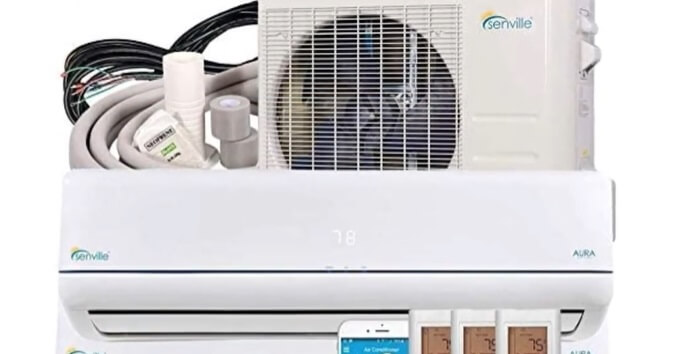| Note: This article may contain affiliate links, which means if you make a purchase following our links won’t cost you extra, but we may earn a commission. Learn more |
A heat pump is a device that transfers heat energy from one place to another. It can be used to heat or cool a space, as well as to maintain the temperature of a space. Heat pumps can be used for both residential and commercial applications.
A heat pump is a device that transfers heat energy from one place to another. It can be used to heat or cool a space, depending on the needs of the user. Heat pumps are often used in homes and businesses to regulate temperature.
Heat pumps work by using refrigerants to transfer heat energy from one place to another. The refrigerant evaporates at a low temperature and condenses at a high temperature, causing the transfer of heat energy.
This process can be reversed, depending on the needs of the user, making the heat pump an effective way to regulate the temperature in both hot and cold climates.

What is Heat Pump?
A heat pump is a device that transfers heat energy from a source of heat to a destination called a “heat sink”. Heat pumps are designed to move thermal energy in the opposite direction of spontaneous heat transfer, by absorbing heat from a cold space and releasing it into a warmer one. A heat pump uses an external power to accomplish the work of transferring energy from the heat source to the heat sink.
Types of Heat Pumps
There are three main types of heat pumps: air-source, ground-source, and water-source.
Air-Source Heat Pumps
Air-source heat pumps are the most common type of heat pump. They transfer heat between your home and the outside air. In the winter, they extract heat from the air and transfer it into your home. In the summer, they reverse the process and remove heat from your home and release it into the outside air.
Ground-Source Heat Pumps
Ground-source heat pumps transfer heat between your home and the ground. In the winter, they extract heat from the ground and transfer it into your home. In the summer, they reverse the process and remove heat from your home and release it into the ground.
Water-Source Heat Pumps
Water-source heat pumps transfer heat between your home and a water source, such as a lake or a well. In the winter, they extract heat from the water and transfer it into your home. In the summer, they reverse the process and remove heat from your home and release it into the water.
How Does a Heat Pump Work?
A heat pump is a mechanical device that transfers heat from one place to another. It can be used to heat a home or office or to cool it down. Heat pumps are powered by electricity, and they work by moving heat from the air outside into the building, or from the ground into the building.
There are two main types of heat pumps: air-source and ground-source. Air-source heat pumps transfer heat from the air outside into the building. Ground-source heat pumps transfer heat from the ground into the building.
Heat pumps work by transferring heat from one place to another. They are powered by electricity, and they use a refrigerant to move heat.
The refrigerant is a fluid that changes state when it absorbs or releases heat. When the refrigerant absorbs heat, it becomes a gas. When it releases heat, it becomes a liquid.
The compressor is the heart of the system; it pressurizes the refrigerant so that it can change states easily. The evaporator coil contains refrigerant in its gaseous form; as it evaporates, it absorbs heat from the surrounding air (or ground). The condenser coil contains refrigerant in its liquid form; as it condenses, it releases heat into the air (or ground).
The expansion valve regulates how much refrigerant is let into the evaporator coils at any given time; this helps keep them working at peak efficiency levels and prevents damage caused by too much pressure build-up within the coils themselves. Finally, a fan helps circulate heated(or cooled)air throughout the living space.
Read More: Why is My Heat Pump Blowing Cold Air? How to Fix it?
What is the Downside of a Heat Pump?
While heat pumps have many advantages, there are also some potential disadvantages to consider. One downside is that heat pumps can be less effective in extremely cold weather. This is because they rely on the air outside to provide heating, and when temperatures are very low, this air may not contain enough heat to sufficiently warm your home.
Additionally, heat pumps can be noisy, especially when they are first turned on. Some models also require more maintenance than others, so it’s important to do your research before purchasing one.
Do Heat Pumps Use a Lot of Electricity?
Heat pumps are one of the most efficient ways to heat and cool your home, but they do use electricity. The amount of electricity a heat pump uses varies depending on the size and efficiency of the unit, as well as the climate. In general, heat pumps use about 1/3 to 1/2 less energy than electric resistance heating, like furnaces and baseboard heaters.
In colder climates, heat pumps may use more electricity because they have to work harder to maintain a comfortable temperature in your home. However, even in these climates, heat pumps are still more efficient than electric resistance heating.
If you’re considering a heat pump for your home, be sure to consult with a qualified HVAC contractor to determine if it’s the best option for you.
How Does a Heat Pump Work in Winter?
When the weather outside is cold, most people rely on their furnaces to keep their homes warm. But did you know that a heat pump can also be used to heat your home in winter? Here’s how it works:
A heat pump contains a refrigerant that evaporates and condenses at different temperatures. In summer, the refrigerant evaporates at a low temperature and absorbs heat from your home. This process reverses in winter, with the refrigerant condensing at a high temperature and releasing heat into your home.
To help the process along, the heat pump uses an electric compressor to circulate the refrigerant. In winter, the compressor runs continuously to keep your home warm. Some models also have a backup heating element that kicks in when needed, providing an extra boost of warmth on particularly cold days.
So there you have it – that’s how a heat pump works to keep your home warm in winter! If you’re thinking of switching to a heat pump or are simply curious about how they work, we hope this article has been helpful.
How Does a Heat Pump Work in a House?
In a heat pump system, a refrigerant circulating within tubing acts as the transfer agent between two heat sources: the cooler outdoors and the warmer indoors. In warm weather, the heat pump moves heat from your cool house into the warm outdoors. This is the mode your air conditioner works in.
In cold weather, the process reverses, and heat is pulled from the cold outdoors and transferred indoors. Refrigerant circulates through a closed loop system between an indoor and outdoor unit. An evaporator coil inside the indoor unit absorbs warmth from household air blowing across it.
The now-warm refrigerant passes through a compressor where its pressure and temperature increase before it enters an outdoor coil. There, it releases its warmth to colder outside air blowing across the coil. That refrigerant vapor then returns to its liquid state in an expansion valve or metering device inside the outdoor unit before recirculating back into the indoor evaporator coil to start absorbing more warmth.
The efficiency of a heat pump can be measured by its heating season performance factor (HSPF). The HSPF is calculated by dividing the total space heating required during the heating season by the total electric energy consumed by the unit during that same period The U.S Department of Energy (DOE) has established minimum HSPFs for new units as follows: 8.2 for units with cooling capacities less than 65,000 Btu/hour
9.6 for units with cooling capacities equal to or greater than 65,000 Btu/hour but less than 135,000 Btu/hour
What are the Disadvantages of a Heat Pump?
A heat pump is a mechanical-compression cycle refrigeration system that can be used for heating or cooling. It uses the evaporation and condensation of a working fluid to transfer heat energy from one place to another. The advantage of using a heat pump is its efficiency in transferring heat energy.
But there are also some disadvantages that you should know about before deciding if this type of system is right for your home. One disadvantage of a heat pump is its initial cost. A quality unit can cost several thousand dollars, which may be more than some homeowners can afford.
Additionally, installation costs can also be high, especially if you need to have ductwork installed in your home.
Another downside to using a heat pump is that it doesn’t work well in extremely cold weather conditions. If the temperature outside drops below freezing, the unit will have to work harder to maintain a comfortable indoor temperature, which can lead to higher utility bills.
Some newer models include a backup heating element that kicks on when the temperature drops too low, but this will add to the overall cost of the unit.
Finally, noise can be an issue with some types of heat pumps. While most units operate quietly, some older model units can be quite loud when they turn on and off.
If noise is a concern for you, make sure to ask about it before making your purchase.
How Does a Heat Pump Work for Air Conditioning?
A heat pump is a device that transfers heat energy from one place to another. Heat pumps are used to raise the temperature of a space by taking in heat from a cooler space and releasing it into a warmer space. The reverse process can also be used to lower the temperature of a space by taking in heat from a warmer space and releasing it into cooler space.

A common type of air conditioner is the split-system central air conditioner, which has an indoor unit and an outdoor unit. The outdoor unit contains the condenser and compressor, while the indoor unit contains the evaporator coil.
When operating in cooling mode, the evaporator coil absorbs heat from the indoor air, while the condenser releases heat to the outdoors. In heating mode, the process is reversed – the evaporator extracts heat from outdoors and transfers it indoors, while the condenser absorbs heat from indoors and releases it outdoors. Heat pumps are more efficient than standard split-system air conditioners because they can use less energy to move heat around.
In fact, when operating in heating mode, a properly sized and installed heat pump can provide up to four times more heating energy than electric resistance heating such as baseboard radiant or furnaces—making them much cheaper to operate! Not only that, but since they don’t produce any combustion byproducts (such as carbon monoxide), they’re also much safer for your family—especially if you have young children or elderly family members living with you who are particularly vulnerable to respiratory illnesses.
Heat Pump Vs Furnace
It’s that time of year again when thoughts turn to heat our homes. For many of us, the decision comes down to a choice between a heat pump and a furnace. So, which is the best option for you?
Let’s take a closer look at each option to help you make your decision. Heat Pump A heat pump is an electrically powered device that moves heat from one place to another.
It can be used for both heating and cooling your home. In the winter, it takes heat from the air outside and brings it into your home. In the summer, it does the reverse and takes heat from your home and sends it outdoors.
Furnace A furnace is a gas- or oil-powered device that heats air and then blows it through ducts into your home. Furnaces are typically more expensive to operate than heat pumps because they use more energy.
However, furnaces can be a good option if you live in an area with very cold winters as they tend to work better in extremely cold temperatures than heat pumps do.
How Does a Heat Pump Work in Summer?
When it’s hot outside, the last thing you want is for your home to be even hotter. But if you have a heat pump, that’s exactly what can happen. A heat pump is designed to move heat from one place to another, and in the summer, that means moving heat from your home into the outdoors.
As a result, your home can end up being much hotter than it would be without a heat pump. So how does a heat pump work in summer? It all has to do with the refrigerant inside the unit.

The refrigerant absorbs heat from your indoor air and then releases it outdoors. This process happens over and over again, and each time, the refrigerant gets warmer and warmer. Eventually, it gets so warm that it starts to cause problems.
If your heat pump is having trouble keeping up with the demand on hot days, there are a few things you can do to help out. First, make sure that all of your doors and windows are closed tightly so that no cool air can escape. Second, try lowering the temperature on your thermostat – this will reduce the amount of work your heat pump has to do.
Finally, if all else fails, you can always turn off your heat pump for a while until things cool down outside!
Heat Pump Vs Air Conditioner
Looking to beat the heat this summer? You may be wondering whether to install a heat pump or an air conditioner. Both types of systems have their pros and cons, so it’s important to weigh your options before making a decision.
Here’s a quick rundown of the key differences between heat pumps and air conditioners:
Heat Pumps
– Heat pumps can both heat and cool your home, making them ideal for all-season use.
– Heat pumps are generally more energy-efficient than air conditioners, so they can help you save on your energy bills.
– Heat pumps require less maintenance than air conditioners.
Air Conditioners
– Air conditioners are better at cooling your home than heat pumps. If you live in a hot climate, an air conditioner may be a better option for you.
– Air conditioners tend to be less expensive than heat pumps up front.
However, over time, the higher operating costs of an air conditioner will likely offset any initial savings.
What Does a Heat Pump Look Like?
What Does a Heat Pump Look Like?A heat pump looks like an air conditioner or furnace, depending on the type of system you have. The outdoor unit will have either coils or a compressor, while the indoor unit will have a furnace.
If you have an older model, the outdoor unit may be larger and sit on the ground. Newer models are more compact and can be mounted on a wall.
Conclusion
A heat pump is a device that transfers heat energy from a source of heat to a destination called a “heat sink”. Heat pumps are designed to work in both hot and cold climates. In the summer, they can be used to cool your home by transferring heat from the inside of your house to the outside.
In the winter, they can be used to heat your home by transferring heat from the outside to the inside.
Featured image credit: www.youtube.com